Why Every Kitchen Needs a Complete Spice List
Whether you're just starting your culinary journey or you're a seasoned home cook, having a complete list of spices is like holding the keys to a flavor kingdom. From warm cinnamon to fiery ghost pepper, every spice tells a story, adds character, and transforms the ordinary into extraordinary.
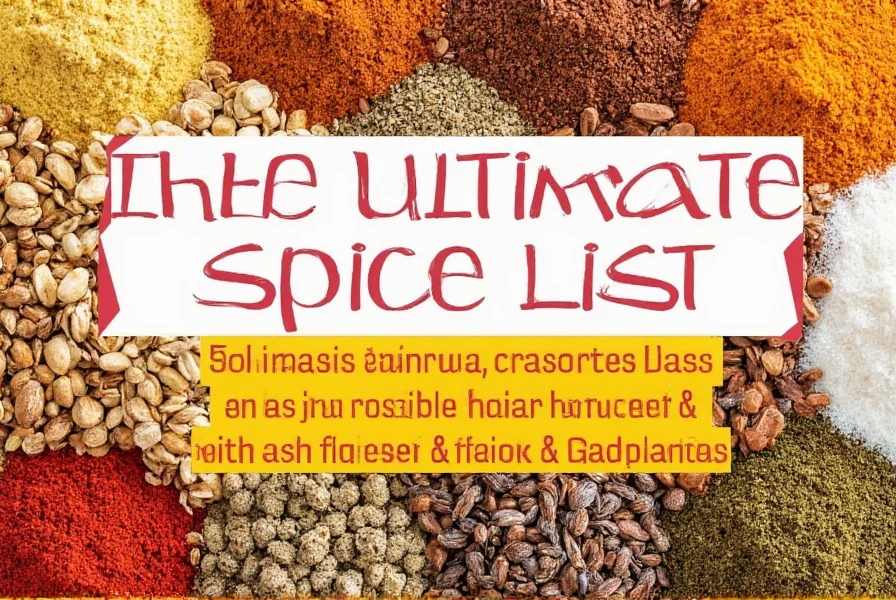
This guide provides a comprehensive overview of essential spices, their flavor profiles, and practical tips for choosing, storing, and using them effectively. By understanding the fundamentals of spice selection and application, you'll gain the confidence to elevate your cooking to new heights.
Essential Spices for Every Kitchen
Here's a curated list of the most versatile and essential spices that form the foundation of global cuisines. These spices offer maximum flavor versatility and are essential for any well-stocked kitchen.
| Name | Type | Origin | Flavor Profile | Best For |
|---|---|---|---|---|
| Cinnamon | Spice | Sri Lanka / India | Warm, sweet, woody | Baking, desserts, chai |
| Cumin | Spice | Middle East | Earthy, nutty, slightly bitter | Tacos, curries, chili |
| Paprika | Spice | Spain / Hungary | Mild, earthy, sweet or spicy | Goulash, stews, rubs |
| Turmeric | Spice | India | Earthy, peppery, musky | Curries, golden milk, anti-inflammatory dishes |
| Coriander | Spice | North Africa / Middle East | Citrusy, floral, light | Curries, pickles, salsas |
| Black Pepper | Spice | India | Peppery, sharp, pungent | All-purpose seasoning, marinades |
| Garlic Powder | Spice | Global | Savory, pungent, umami | Soups, sauces, rubs |
| Oregano | Herb | Greece | Robust, earthy, peppery | Pizza, grilled veggies, tomato sauces |
| Basil | Herb | Italy | Herby, sweet, fresh | Pesto, pasta, Caprese salad |
| Chili Powder | Blend | Mexico | Smoky, spicy, earthy | Tacos, enchiladas, chili con carne |
| Bay Leaf | Herb | Mediterranean | Subtle, herbal, woodsy | Stocks, soups, braises |
| Thyme | Herb | Mediterranean | Woody, savory, subtle | Roasted meats, stews, stocks |
| Mustard Seeds | Spice | India | Sharp, tangy, nutty | Curries, pickling, vinaigrettes |
| Smoked Paprika | Spice | Spain | Deep, smoky, rich | Barbecue rubs, stews, roasted vegetables |
| Garam Masala | Blend | India | Warm, aromatic, rich | Indian dishes, rice, stews |
Understanding Spice Categories
Spices fall into distinct categories that determine their usage and flavor contribution. Understanding these categories helps you organize your pantry and make informed choices when cooking.
- Whole Spices: Seeds, bark, roots, or berries used in their natural form (e.g., cumin seeds, black peppercorns). Whole spices maintain freshness longer and can be ground fresh for maximum flavor.
- Ground Spices: Finely powdered forms of whole spices (e.g., cinnamon powder, turmeric). Ground spices release flavor more quickly but lose potency faster than whole spices.
- Dried Herbs: Dehydrated leaves from aromatic plants (e.g., oregano, thyme, rosemary). Ideal for long-cooked dishes like soups and stews.
- Fresh Herbs: Leafy greens used in their natural state (e.g., cilantro, basil, parsley). Best added at the end of cooking to preserve freshness.
- Blends: Combinations of multiple spices designed for specific culinary applications (e.g., garam masala, curry powder, five-spice powder).
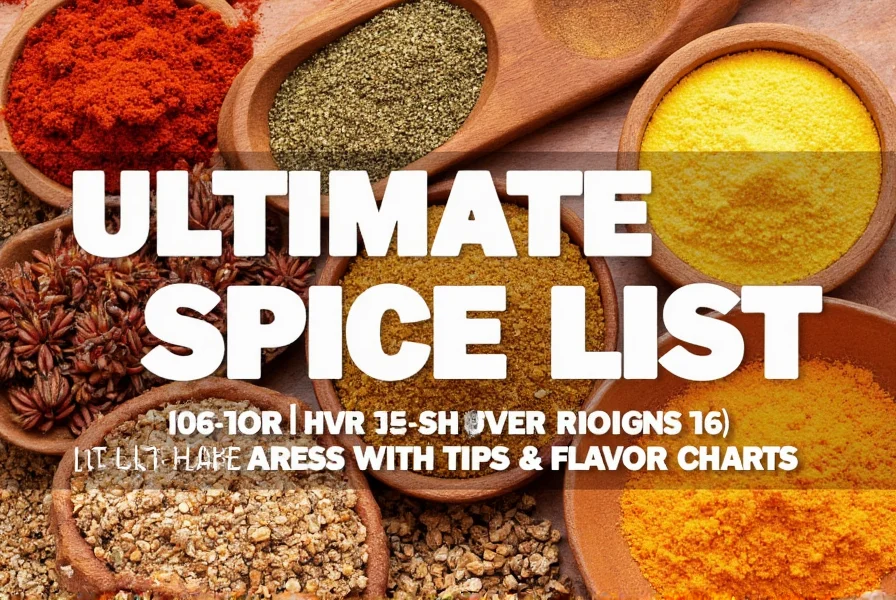
Flavor Profile Guide: Sweet, Earthy, Smoky & Hot
Spices can be categorized by their dominant flavor characteristics. This guide helps you understand how to combine spices effectively to create balanced and complex flavors.
| Flavor Type | Examples | Use Case |
|---|---|---|
| Sweet | Cinnamon, cardamom, allspice, nutmeg | Desserts, baked goods, beverages |
| Earthy | Cumin, coriander, turmeric, fenugreek | Curries, stews, grain dishes |
| Smoky | Smoked paprika, chipotle powder, sumac | Grilled meats, rubs, dips |
| Hot | Cayenne, ghost pepper, red chili flakes | Spicy sauces, marinades, bold dishes |
| Citrusy | Sumac, lemon pepper, coriander seed | Salads, fish, Middle Eastern cuisine |
| Floral | Saffron, cardamom, star anise | Rice dishes, desserts, cocktails |
How to Choose the Best Spices
Not all spices are created equal. Knowing what to look for when shopping ensures you get the best quality and flavor for your money.
What to Look For
- Whole vs. Ground: Whole spices last longer and can be ground fresh. Ground spices are convenient but lose potency faster.
- Brand Reputation: Choose trusted brands like Penzey's, Simply Organic, or The Spice Garden for quality and purity.
- Expiration Dates: Most spices stay fresh for 1-3 years. Check labels or grind a small amount to test aroma.
- Color and Aroma: Vibrant color and strong scent indicate freshness. Avoid dull or faded spices.
- Organic & Non-GMO: Especially important for blends where additives might be present.
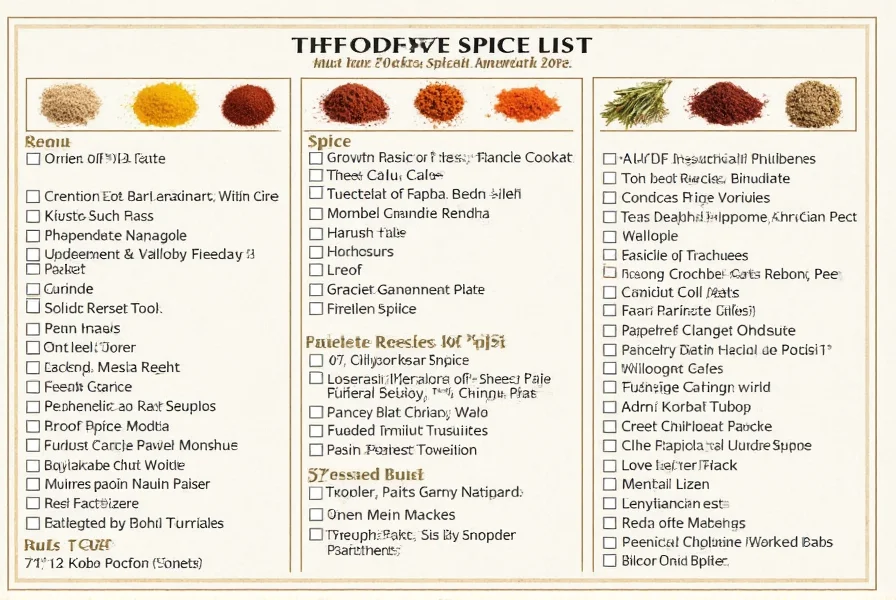
Storage Secrets: Keep Your Spices Fresh Longer
Proper storage is crucial for maintaining flavor and potency. Follow these guidelines to maximize your spice investment.
- Use Airtight Containers: Oxygen degrades flavor. Store in glass jars with tight lids.
- Keep Cool and Dry: Heat and humidity reduce potency. Avoid storing near the stove.
- Limit Light Exposure: UV rays break down flavor compounds. Dark cabinets are ideal.
- Label Everything: Write purchase dates on containers to track freshness.
- Buy in Small Quantities: Unless you're using large volumes, avoid bulk purchases unless you're certain you'll use it.
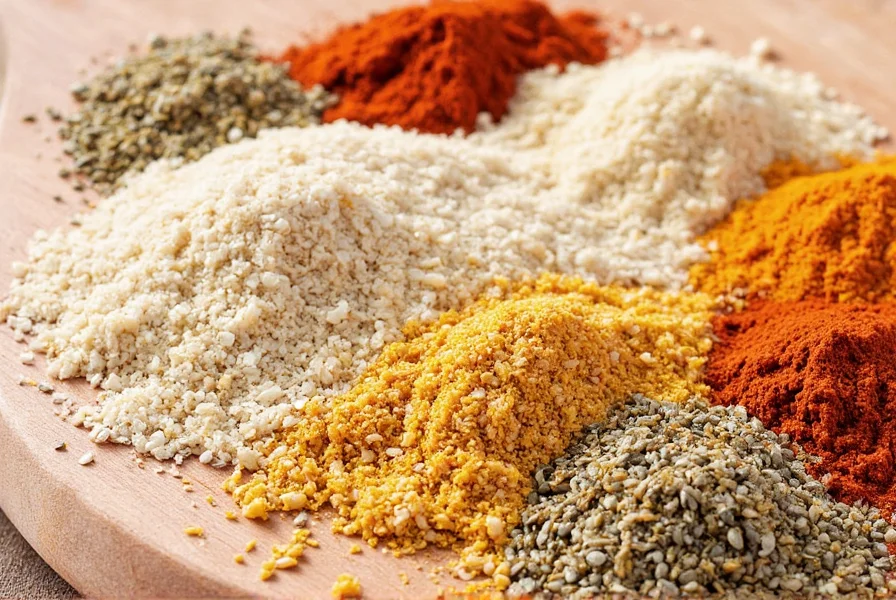
Spice by Cuisine: Which Spices Go with What Food?
Each culture has its own unique flavor fingerprint. Use this reference to build authenticity in your global dishes.
| Cuisine | Signature Spices | Iconic Dishes |
|---|---|---|
| Indian | Garam masala, cumin, coriander, turmeric | Butter chicken, dal tadka, biryani |
| Mexican | Cumin, chili powder, oregano, smoked paprika | Enchiladas, tacos al pastor, pozole |
| Chinese | Five-spice powder, star anise, ginger, garlic | Kung pao chicken, red-braised pork, hot pot |
| Middle Eastern | Za'atar, sumac, cinnamon, allspice | Hummus, shakshuka, kebabs |
| Italian | Oregano, basil, garlic powder, fennel seed | Lasagna, pizza, minestrone |
| Thai | Lemongrass, galangal, coriander root, kaffir lime | Pad Thai, green curry, tom yum soup |
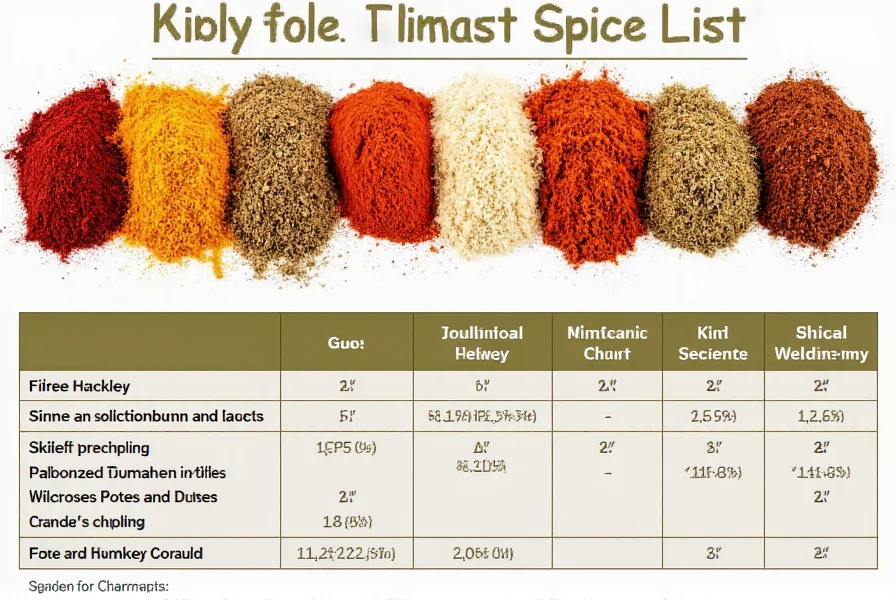
Frequently Asked Questions About Spices
Got questions about spices? We've got answers! Here are some of the most common queries from home cooks just like you.
How long do spices typically last?
Whole spices generally last 3-4 years, while ground spices last 2-3 years. Herbs last about 1-3 years. The best way to check freshness is to smell them - if the aroma is weak, it's time to replace them. Store spices properly in airtight containers away from light and heat to maximize their shelf life.
What's the difference between herbs and spices?
Herbs come from the leafy parts of plants (like basil, cilantro, and oregano), while spices come from other parts of the plant such as seeds (cumin), roots (ginger), bark (cinnamon), or flowers (clove). Generally, herbs are milder and used fresh or dried with main dishes, while spices tend to have stronger flavors and are often used in smaller quantities.
Which 5 spices should every kitchen have?
Every kitchen should start with: 1) Salt, 2) Black pepper, 3) Cumin, 4) Paprika, and 5) Cinnamon. These provide a versatile base for most cuisines and can be expanded upon as you develop your cooking skills. With just these five, you can create everything from chili to roasted vegetables to baked goods.
How can I tell if my spices are still fresh?
Fresh spices should have vibrant color and strong aroma. If they look faded or you can barely smell them, they've likely lost potency. A simple test: rub a small amount between your fingers - if little aroma is released, it's time to replace them. Another test is to sprinkle a small amount into hot liquid - fresh spices will immediately release their fragrance.
Can I substitute one spice for another?
Yes, but with some caveats. For example, coriander can sometimes substitute for cumin (though they're quite different), and allspice can mimic a blend of cinnamon, nutmeg, and cloves. However, some spices like saffron or cardamom have unique flavors that are hard to replicate exactly. When substituting, start with half the recommended amount and adjust to taste.
Are there health benefits to using spices?
Many spices offer health benefits. Turmeric contains curcumin with anti-inflammatory properties, cinnamon may help regulate blood sugar, and ginger aids digestion. However, they should complement a healthy diet, not replace medical treatment. Most spices are rich in antioxidants and can contribute to overall wellness when used regularly in cooking.
What's the difference between regular and smoked paprika?
Regular paprika is made from ground sweet peppers and has a mild, earthy flavor. Smoked paprika is made from peppers that have been smoked and dried over oak fires, giving it a distinctive deep, smoky flavor that adds complexity to dishes. Spanish paprika (pimentón) comes in sweet (dulce), bittersweet (agridulce), and hot (picante) varieties, each with different smoke levels.
Should I buy whole spices and grind them myself?
If possible, yes. Whole spices retain their flavor and aroma much longer than pre-ground versions. Grinding them fresh just before use releases maximum flavor. A dedicated spice grinder or mortar and pestle works well for this purpose. While it requires a bit more effort, the difference in flavor is noticeable, especially with spices like cumin, coriander, and pepper.
Building Your Spice Cabinet Masterpiece
Building a well-stocked spice cabinet is one of the most rewarding investments you can make in your cooking journey. With this comprehensive guide and expert tips, you're ready to experiment boldly and confidently. Don't be afraid to mix, match, and personalize your spice lineup — after all, great cooking is all about flavor and fun!
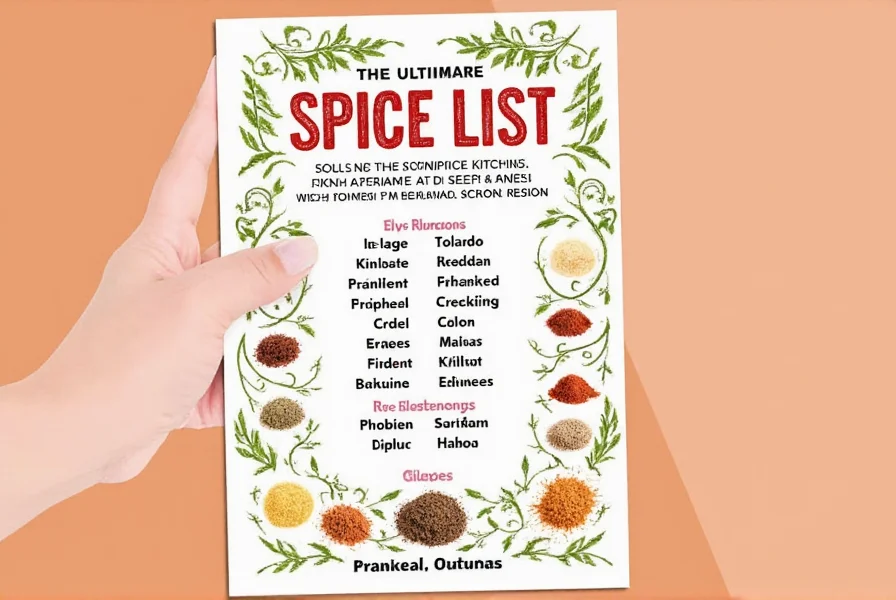
Remember: spices aren't just ingredients — they're magic potions that transform the mundane into memorable. So grab your spoon, sprinkle some joy, and let your inner chef shine!










 浙公网安备
33010002000092号
浙公网安备
33010002000092号 浙B2-20120091-4
浙B2-20120091-4